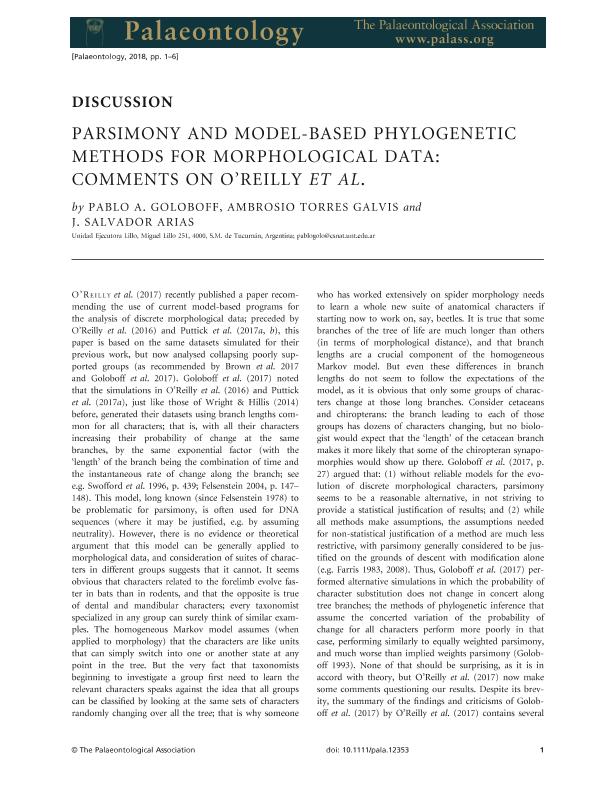Artículo
Parsimony and model-based phylogenetic methods for morphological data: comments on O'Reilly et al .
Fecha de publicación:
04/2018
Editorial:
Wiley Blackwell Publishing, Inc
Revista:
Palaeontology
ISSN:
0031-0239
Idioma:
Inglés
Tipo de recurso:
Artículo publicado
Clasificación temática:
Resumen
O´Reilly et al. (2017) have recently published a paper recommending the use of current model-basedprograms for the analysis of discrete morphological data; preceded by O´Reilly et al. (2016) and Puttick et al.(2017a, b), this paper is based on the same datasets simulated for their previous paper, but now analyzedcollapsing poorly supported groups (as recommended by Brown et al. 2017 and Goloboff et al. 2017).Goloboff et al. (2017) noted that the simulations in O´Reilly et al. (2016) and Puttick et al. (2017a), just likethose of Wright and Hillis (2014) before, generated their datasets using branch lengths common for allcharacters ? that is, with all their characters increasing their probability of change at the same branches, by thesame exponential factor (with the ?length? of the branch being the combination of time and the instantaneousrate of change along the branch; see e.g. Swofford et al. 1996, p. 439, Felsenstein 2004, p. 147?148). Thismodel, long known (since Felsenstein 1978) to be problematic for parsimony, is often used for DNAsequences (where it may be justified, e.g. by assuming neutrality). However, there is no evidence ortheoretical argument that this model can be generally applied to morphological data, and consideration ofsuites of characters in different groups suggests it cannot. It seems obvious that characters related to forelimbevolve faster in bats than in rodents, and that the opposite is true of dental and mandibular characters; everytaxonomist specialized in any group can surely think of similar examples. The homogeneous Markov modelassumes (when applied to morphology) that the characters are like units that can simply switch into one oranother state at any point in the tree. But the very fact that taxonomists first learning a group need to learn therelevant characters speaks against the idea that all groups can be classified by looking at the same sets ofcharacters randomly changing over all the tree ? that is why someone who has worked extensively on spidermorphology needs to learn a whole new suite of anatomical characters if starting now to work on, say, beetles.It is true that some branches of the tree of life are much longer than others (in terms of morphologicaldistance), and that branch lengths are a crucial component of the homogeneous Markov model.
Palabras clave:
PHYLOGENETICS
,
PARSIMONY
,
SIMULATIONS
Archivos asociados
Licencia
Identificadores
Colecciones
Articulos(UEL)
Articulos de UNIDAD EJECUTORA LILLO
Articulos de UNIDAD EJECUTORA LILLO
Citación
Goloboff, Pablo Augusto; Torres Galvis, Ambrosio; Arias Becerra, Joan Salvador; Parsimony and model-based phylogenetic methods for morphological data: comments on O'Reilly et al .; Wiley Blackwell Publishing, Inc; Palaeontology; 61; 4; 4-2018; 625-630
Compartir
Altmétricas




